14.1 About Volcanoes
Describe three main types of volcanoes and major landforms associated with each.
active volcano
A volcano that has erupted during the last 10,000 years and is likely to erupt again.
extinct volcano
A volcano that has not erupted for tens of thousands of years and can never erupt again.
Volcanoes shape Earth’s crust. They can pour cubic kilometers of lava onto Earth’s surface to build new islands and landmasses. They form beautiful snow-
Active volcanoes—those that have erupted in the last 10,000 years and could erupt again—
Three Types of Volcanoes
stratovolcano
(or composite volcano) A large, potentially explosive cone-
pyroclast
(or pyroclastic materials) Any fragment of solid material that is ejected from a volcano, ranging in size from ash to large boulders.
ash (volcanic)
Fine volcanic powder consisting of pulverized rock particles and solidified droplets of lava.
Volcanoes are surface landforms created by accumulations of the materials they emit over time. Although they take on many shapes and sizes, most volcanoes can be categorized as either stratovolcanoes, shield volcanoes, or cinder cones.
A stratovolcano, or composite volcano, is a large, potentially explosive, cone-

Figure 14.2
 Animation
Animation
Stratovolcano formation
http:/
shield volcano
A broad, domed volcano formed from many layers of basaltic lava.
A shield volcano is a broad, domed volcano formed from many layers of fluid basaltic lava (Figure 14.3). Shield volcanoes are much larger than stratovolcanoes. In fact, they are so large that they can be difficult to identify as volcanoes from the ground. Instead, they look like a broad, gently sloped horizon.
446

Figure 14.3
 Animation
Animation
Shield volcano formation
http:/
cinder cone
A small, cone-
angle of repose
The steepest angle at which loose sediments can settle.
Cinder cones are small, cone-
Most cinder cones are less than 400 m (1,300 ft) high, and are roughly symmetrical. Many cinder cones erupt for a few decades or less, then become extinct. Structurally, cinder cones are the simplest of the three types of volcanoes, as illustrated in Figure 14.4.
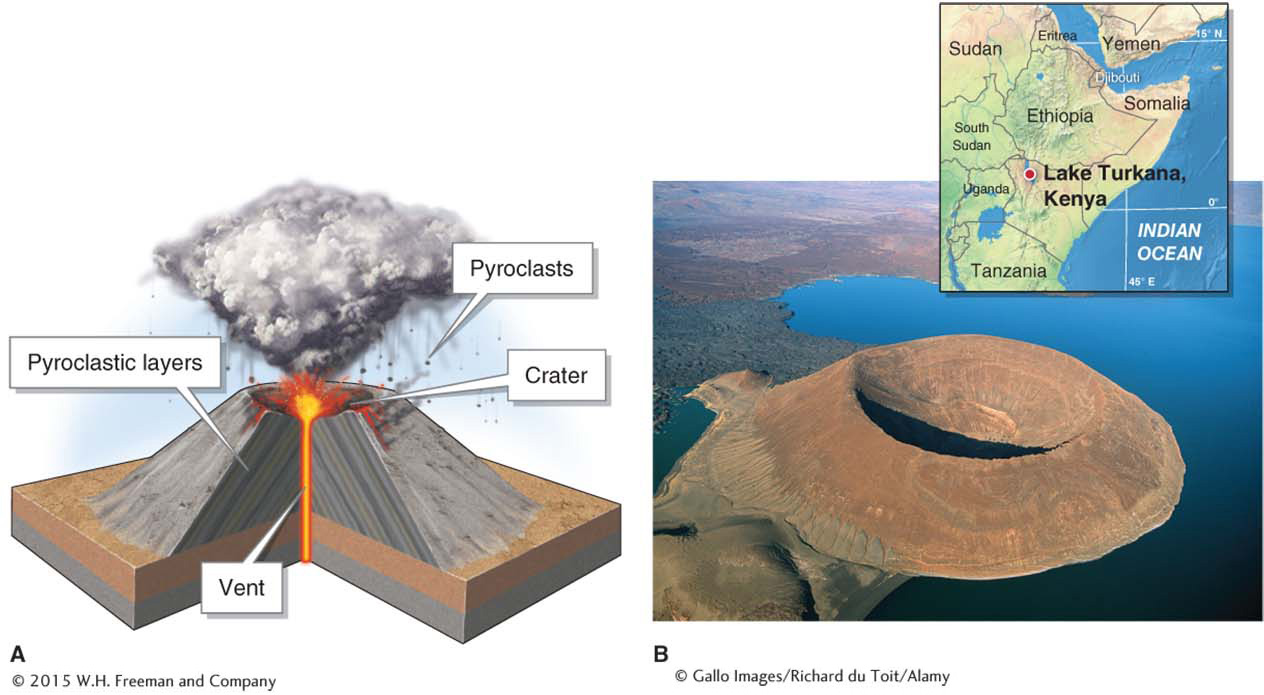
Figure 14.4
 Animation
Animation
Cinder cone formation
http:/
Cinder cones are the smallest type of volcano. Figure 14.5 illustrates and compares the differences in the extents of the three volcano types.

Figure 14.5
What Do Volcanoes Make?
Active stratovolcanoes and shield volcanoes make and eject a variety of physical materials, ranging in size from fine ash to large boulders, and they create landforms from small volcanic craters to vast lava fields. Here we discuss three categories of volcanic products: lavas, pyroclasts and gases, and volcanic landforms.
447
Molten Rock: Lava
Lava is one of the most conspicuous products of volcanic activity. Lava comes only from volcanoes or volcanic fissures in the ground. Lava flows range from fast-
The thickness of a material is called its viscosity. The higher a material’s viscosity, the more resistant it is to flowing. The viscosity of lava is controlled by many factors, including its temperature, gas content, crystal content, and silica (SiO2) content. Silica plays an important role in determining lava viscosity because it forms long chains of molecules that bind the lava together.
pāhoehoe
(pronounced pa-
Three types of lava can be classified according to their silica content and temperature: mafic, intermediate, and felsic. Mafic lava has a temperature of about 1,000°C to 1,200°C (1,800°F to 2,200°F), has a silica content of 50% or less, has a low viscosity, and flows easily. Mafic lava builds shield volcanoes. When mafic lava solidifies into smooth, billowy lobes over the surface, it is called pāhoehoe (Figure 14.6A). When it takes on a blocky, rough surface, it is called ’a’ā.
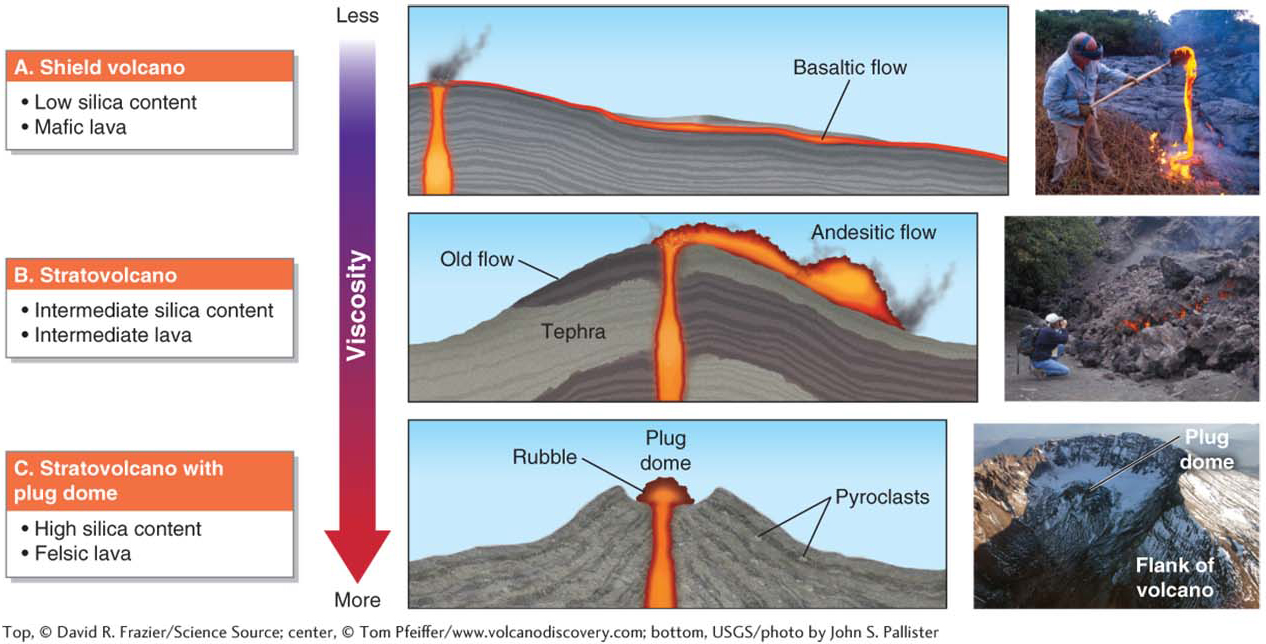
Figure 14.6
Intermediate lava has a temperature of about 800°C to 1,000°C (1,500°F to 1,800°F), a silica content between 50% and 70%, and a medium viscosity (Figure 14.6B). Andesitic lava, often called blocky lava because of its blocky texture as it moves downslope, is one type of intermediate lava. Stratovolcanoes are composed mostly of intermediate lava and felsic lava.
Of the three lava types, felsic lava has the coolest temperature, at about 650°C to 800°C (1,200°F to 1,500°F), and the highest silica content, 70% or more. Its resulting high viscosity restricts its ability to flow. Plug domes, which may block volcanic vents, are composed of viscous felsic lava (Figure 14.6C).
448
What determines the amount of silica in magma? Two main factors determine its silica content: the makeup of the solid mantle material from which the magma first melted and the type of rock the magma passes through on its way to the surface of the crust. For example, as magma migrates through granitic crust in a subduction zone, it will partially melt the surrounding granite through which it is passing (see Section 13.2). Granite is high in silica and will be mixed into the magma, creating a felsic magma. On the other hand, magma migrating up through basaltic oceanic crust, as it does at a hot spot, becomes mafic lava that spills from a volcano. Mafic lava forms many spectacular lava features, two of which are shown in Figure 14.7.
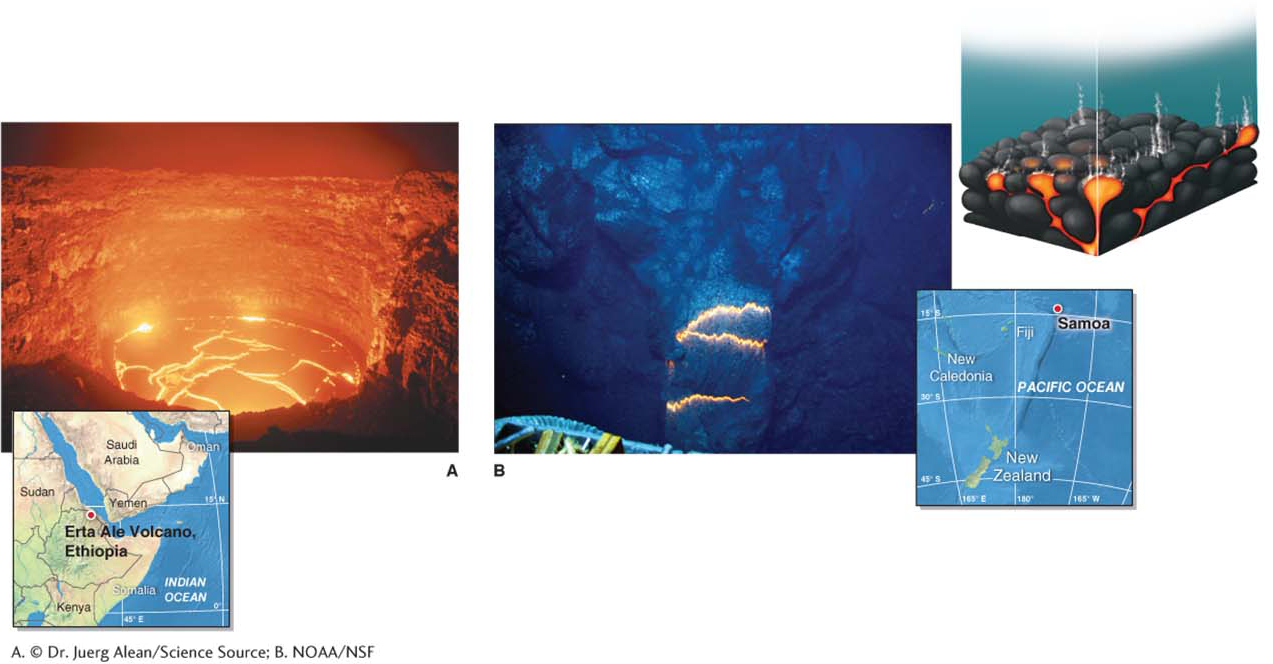
Figure 14.7
Mafic lava that erupts beneath the ocean forms rounded pillow lava (Figure 14.7B). Because most volcanic activity on Earth occurs at divergent plate boundaries along mid-
Blown into the Air: Pyroclasts and Gases
Explosive volcanic eruptions produce pyroclasts with a wide range of sizes, shapes, and consistencies. Some common types of pyroclasts are described here.
Volcanic ash: Volcanic eruptions can spray droplets of lava high into the air, which solidify as they cool. In powerful explosive eruptions, existing rock from the volcano can also be pulverized into a fine powder and ejected into the atmosphere. These materials constitute volcanic ash, which is very fine-
lapilli
(pronounced la-
pumice
A lightweight, porous rock with at least 50% air content, formed from felsic lava.
Lapilli and pumice: Two other types of pyroclasts are lapilli and pumice. Both are formed from intermediate and felsic lava. Lapilli are marble-
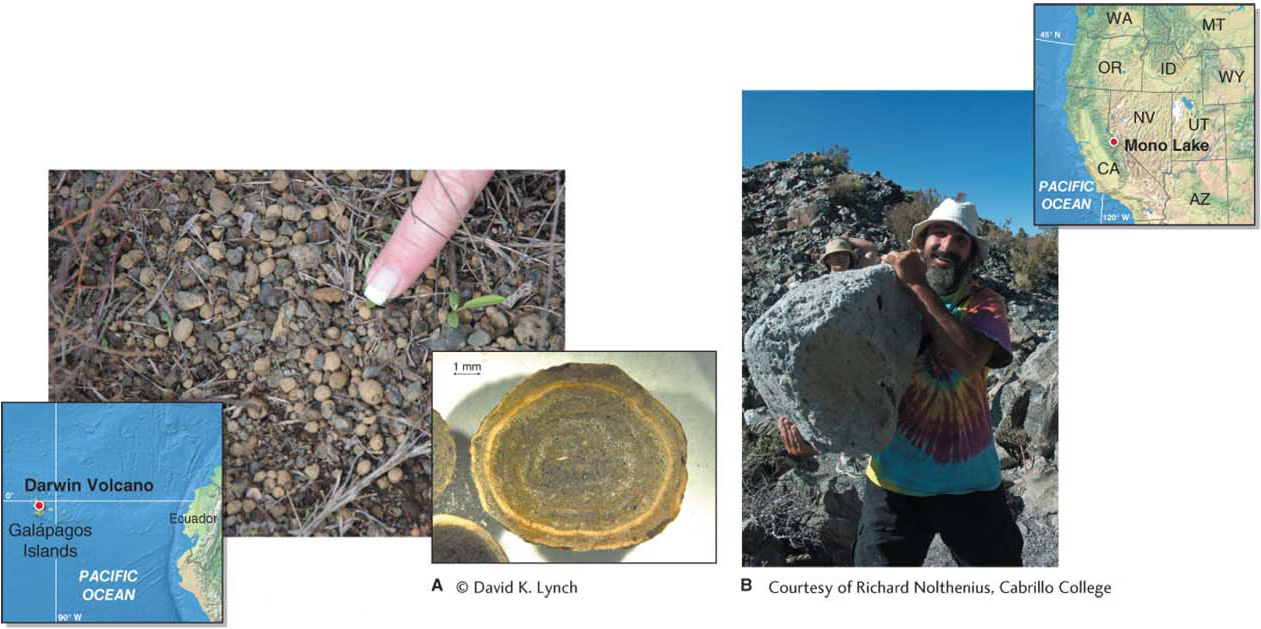
Figure 14.8
bomb (volcanic)
A streamlined fragment of lava ejected from a volcano that cooled and hardened as it moved through the air.
block (volcanic)
A fragment of rock from the volcano’s cone that is ejected during an explosive eruption.
Volcanic bombs and blocks: A volcanic bomb is a streamlined fragment of lava ejected from a volcano that cooled and hardened as it was still moving through the air. A volcanic block is a fragment of rock from the volcano’s cone that is ejected during an explosive eruption (Figure 14.9).

Figure 14.9
Volcanic gases: By volume, about 8% of most magma is gas. Gas is not a pyroclastic material, but gas emissions produce pyroclasts. As gas forcefully exits a volcano, it blasts lava and rock debris into the air, generating pyroclasts. Gas in magma expands as the magma migrates toward the surface of the crust, where there is less pressure. At the surface, the gases in magma expand rapidly, creating an explosion.
449
Aside from their role in generating pyroclasts, volcanic gases are not usually lethal to people. The main gases emitted by volcanoes are water vapor, carbon dioxide, sulfur dioxide, and hydrogen sulfide (H2O, CO2, SO2, and H2S). Where volcanic gases are concentrated, however, they can be lethal. An example of this occurred near Lake Nyos, in Cameroon, in western Africa, in 1986. Lake Nyos is located on an inactive volcano. A magma chamber below the lake leaks CO2 into the lake. Occasionally, the CO2 is released from the lake in a sudden outgassing event. In August 1986, the lake is thought to have emitted about 1.6 million tons of CO2, suffocating 1,700 people and 3,500 head of livestock.
450
451
After the Lava Cools: Volcanic Landforms
joint
A crack or weak plane in rock.
columnar jointing
A geometric pattern of angular columns that forms from joints in basaltic lava during cooling.
Volcanic landforms are typically very conspicuous on Earth’s surface. Some notable volcanic landforms, in addition to volcanic mountains, are columnar jointing, large igneous provinces, and calderas.
Columnar jointing: As basaltic lava cools and hardens into rock, cracks and weak planes in the rock, called joints, develop. A geometric jointing pattern called columnar jointing, shown in Figure 14.10, sometimes forms, in which angular columns result from joint formation in the lava during cooling.
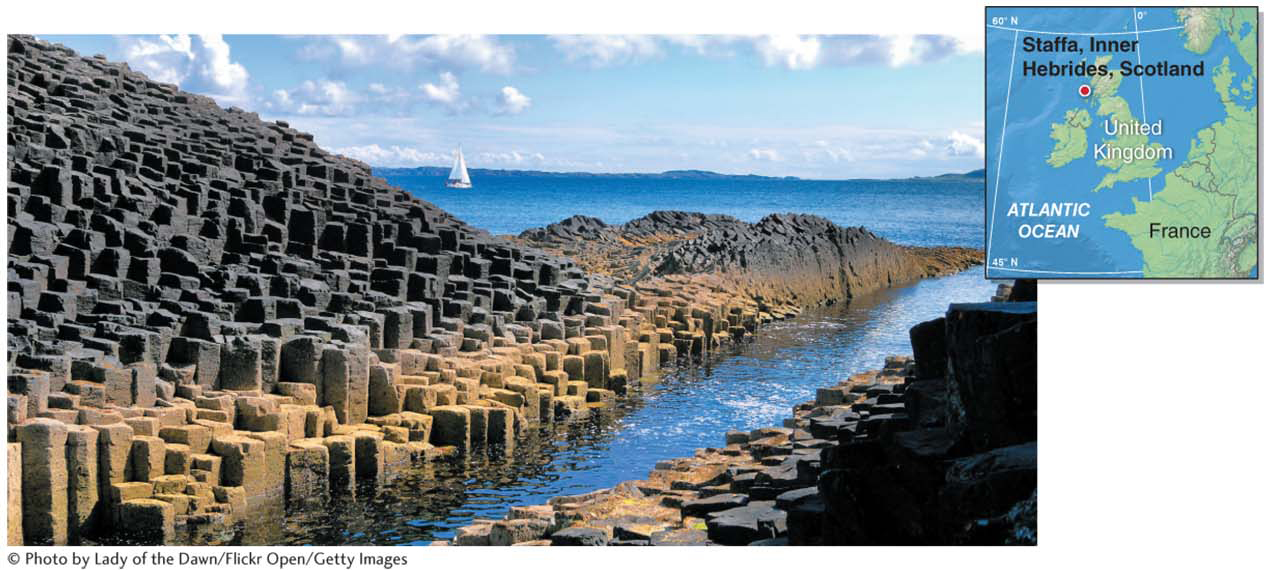
Figure 14.10
large igneous province (LIP)
An accumulation of flood basalts that covers an extensive geographic area.
Large igneous provinces: Large igneous provinces (LIPs) are accumulations of basaltic lava that cover extensive geographic areas. If you have ever driven through eastern Washington and Oregon, you drove over the Columbia Plateau. The rocks of the Columbia Plateau superficially resemble sedimentary rocks, but they are flood basalts, lava flows that poured onto the crust over several million years. The Columbia Plateau flows formed between 17 million and 6 million years ago and created a large igneous province. There are several dozen large igneous provinces around the world (Figure 14.11).

Figure 14.11
caldera
A large depression that forms when a volcano’s magma chamber empties and collapses after the volcano erupts.
Calderas: After an eruption, the emptied magma chamber can collapse, forming a large circular depression called a caldera (from the Spanish word for “cauldron”). The process of caldera formation is illustrated in Figure 14.12. Calderas can be many kilometers in diameter. They usually have flat bases and steep slopes. Calderas can be mistaken for meteor impact craters, but the two can be differentiated because each leaves different types of evidence (Picture This).
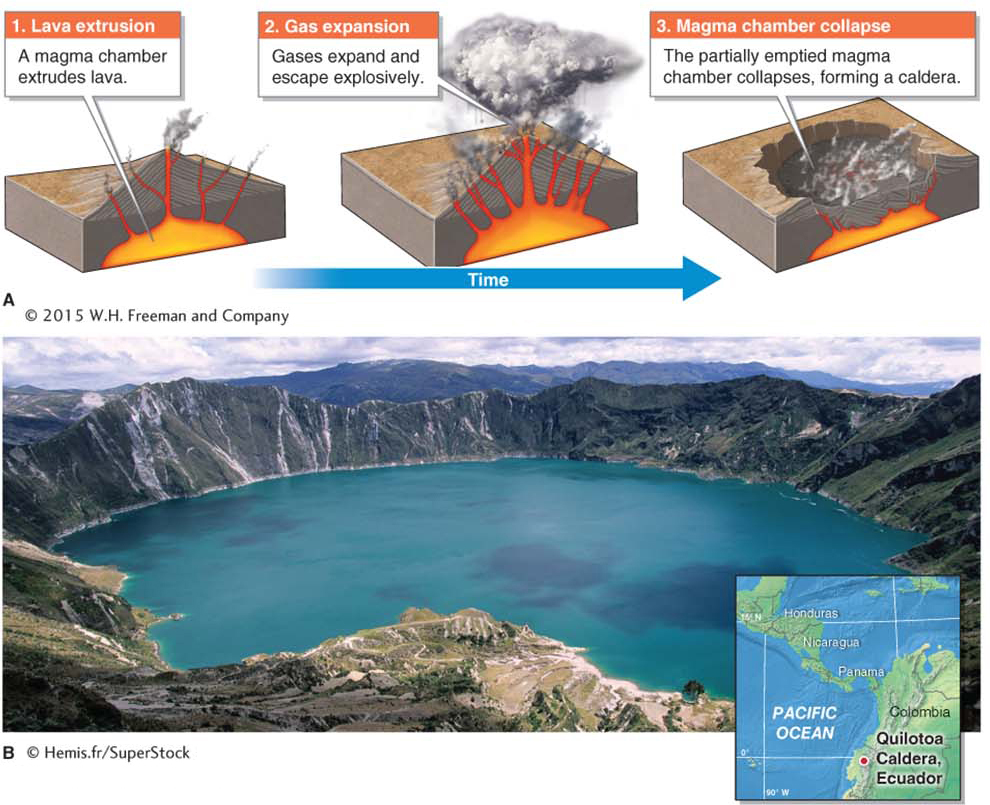
Figure 14.12
 Animation
Animation
Caldera formation
http:/
452
Picture This
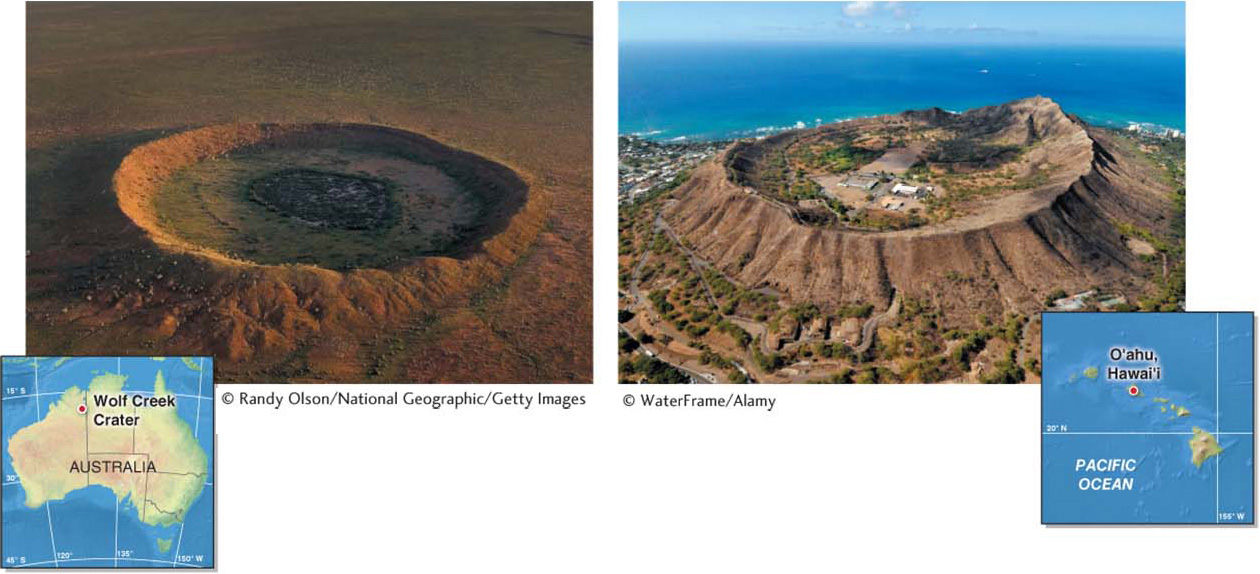
© WaterFrame/Alamy
Which Is the Caldera?
One of these photos shows a volcanic caldera, and one shows an impact crater formed when a meteor struck Earth long ago. Based on the visual evidence from these photos, it is challenging to tell which is the impact crater and which is the caldera. More information is needed. One useful form of evidence is shatter cone rock. Meteors hit the planet with such force that the impact energy produces metamorphic shatter cones. Shatter cones are produced only at meteor impact sites. They are not visible in either of these photos.
Consider This
Question 14.2
ykwo0t24BbBfGzsmdfB3cGvbdxFNxd2oP7NQovTTakrtqna41ESbCeI1MBmisbRDZMZuINNyYS/MPSfz0GjFntf/6MLq/bDewjuRm7KFbmpkduuyNYGozuz5J6bick+XX8t9JA1Nu5tjxio9av3/xAy6yh6NBy4Zy+d+yX3dpp9g8/Ma2Oz3U7FIlzh8/klk3ruTgIhxxBFFn9snqVrqQn0J5V3FfR0cQuestion 14.3
9SAvqfqtffCgKwIs9FUqJKLWP2Xylsfn57eOytVcp/Gv/iYzv3yyC3Hu57wW7WDerh9vsKixqTq5nggS4ejpxUe2a06Awq1KkNV+l5bMZ+zJerjCIc3YD2eI5I6oQHNwR5MruW5j/jPIGN8k7BD1kOj/O3ZeAYHfqGLfNxapjuBUJEtdOeelE0HCU+1mOoWY7sKA1f8t+pBjJfqUAMn0oTcupY+U4qgVC+SflJFs3BXONqIq8g9b0wR7Gx2WEaMcK6pplstJdiZCjTILSHDnBFd+HRsFTAASa1ut7Unm+tOlLWFcw7lI+wP8vBfMhN6HP1K7m7/8LtTqUfxmmLER/9qMNIN2awYykFVSNgYReG8QJKfUqHxuRxRm313oQoigt/PcxLsksQ5XJvhbDGRJiXbW1SPKiopJgItFc8I92D5X+/nZXEQvgQ==